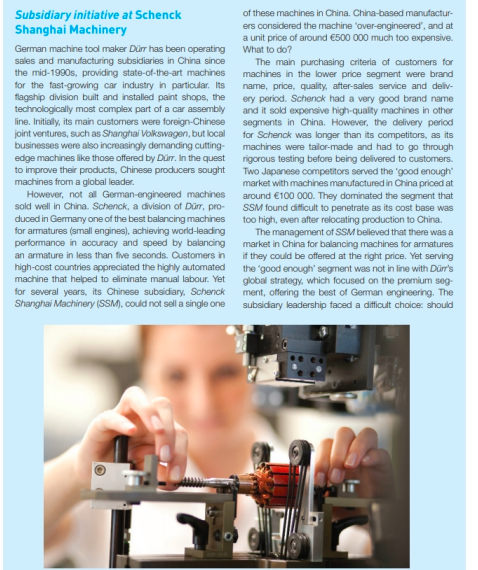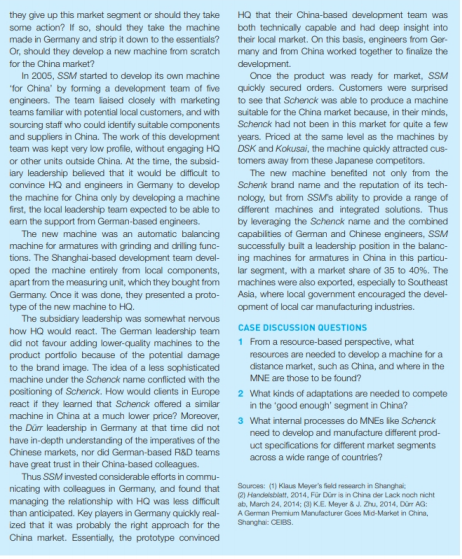Read the case from attached pictures "Appendix_Week_10T_C15_Subsidiary_Initiative_at_Schenck_Shanghai_ Machinery" and answer question 10.3.
Question 10.3.
a)From a resource-based perspective: what resources are needed to develop a machine for a distance market, such as China, and where in the MNE are those to be found?
b)What kinds of adaptations are needed to compete in the 'good enough' segment in China?
Subsidiary initiative at Schenck of these machines in China. China-based manufacture Shanghai Machinery ers considered the machine "over-engineered", and at a unit price of around (500 000 much too expensive. German machine tool maker Dur has been operating What to do? sales and manufacturing subsidiaries in China since The main purchasing criteria of customers for the mid-1990s, providing state-of-the-art machines machines in the lower price segment were brand for the fast-growing car industry in particular, Its name, price, quality, after-sales service and deliv flagship division built and installed paint shops, the ery period. Schenick had a very good brand name technologically most complex part of a car assembly and it sold expensive high-quality machines in other line. Initially, its main customers were foreign-Chinese segments in China. However, the delivery period joint ventures, such as Shanghai Volkswagen, but local for Schenck was longer than its competitors, as its businesses were also increasingly demanding cutting- machines were tailor-made and had to go through edge machines like those offered by Dur. In the quest rigorous testing before being delivered to customers. to improve their products, Chinese producers sought Two Japanese competitors served the 'good enough" machines from a global leader. market with machines manufactured in China priced at However, not all German-engineered machines around (100 000. They dominated the segment that sold well in China. Schenck, a division of Dur, pro- SSM found difficult to penetrate as its cost base was duced in Germany one of the best balancing machines too high, even after relocating production to China. for armatures (small engines), achieving world-leading The management of SSM believed that there was a performance in accuracy and speed by balancing market in China for balancing machines for armatures an armature in less than five seconds. Customers in If they could be offered at the right price. Yet serving high-cost countries appreciated the highly automated machine that helped to eliminate manual labour. Yet the 'good enough' segment was not in line with Dur's for several years, its Chinese subsidiary, Schenck global strategy, which focused on the premium seg- Shanghai Machinery (SSM), could not sell a single one ment, offering the best of German engineering. The subsidiary leadership faced a difficult choice: shouldthey give up this market segment or should they take HQ that their China-based development team was some action? If so, should they take the machine both technicaly capable and had deep insight into made in Germany and strip it down to the essentials? their local market. On this basis, engineers from Ger. Or, should they develop a new machine from scratch many and from China worked together to finalize the for the China market? development. In 2005, SSM started to develop its own machine Once the product was ready for market, SSM "for China" by forming a development team of five quickly secured orders. Customers were surprised engineers. The team Raised closely with marketing to see that Schenck was able to produce a machine teams familiar with potential local customers, and with suitable for the China market because, in their minds, sourcing staff who could identify suitable components Schenck had not been in this market for quite a few and suppliers in China. The work of this development years. Priced at the same level as the machines by team was kept very low profile, without engaging HQ DSK and Kokusai, the machine quickly attracted ous- or other units outside China. At the time, the subsid- tomers away from these Japanese competitors. lary leadership believed that it would be difficult to The new machine benefited not only from the convince HQ and engineers in Germany to develop Schenk brand name and the reputation of its tech- the machine for China only by developing a machine nology, but from SSM's ability to provide a range of first, the local leadership team expected to be able to different machines and integrated solutions. Thus earn the support from German-based engineers. by leveraging the Schenick name and the combined The new machine was an automatic balancing capabilities of German and Chinese engineers, SSM machine for armatures with grinding and drilling func- successfully built a leadership position in the balance tions. The Shanghai-based development team devel- ing machines for armatures in China in this particu- oped the machine entirely from local components, lar segment, with a market share of 35 to 40%. The apart from the measuring unit, which they bought from machines were also exported, especially to Southeast Germany. Once it was done, they presented a proto- Asia, where local government encouraged the devel- type of the new machine to HQ. opment of local car manufacturing industries. The subsidiary leadership was somewhat nervous how HQ would react. The German leadership team CASE DISCUSSION QUESTIONS did not favour adding lower-quality machines to the 1 From a resource-based perspective, what product portfolio because of the potential damage resources are needed to develop a machine for a to the brand image. The idea of a less sophisticated distance market, such as China, and where in the machine under the Schenck name conflicted with the MNE are those to be found? positioning of Schonick. How would clients in Europe 2 What kinds of adaptations are needed to compete react if they learned that Schenck offered a similar in the 'good enough' segment in China? machine in China at a much lower price? Moreover, the Durr leadership in Germany at that time did not 3 What internal processes do MNEs like Schenck have in-depth understanding of the imperatives of the need to develop and manufacture different prod- Chinese markets, nor did German-based R&D teams uct specifications for different market segments have great trust in their China-based colleagues. across a wide range of countries? Thus SSM invested considerable efforts in commu- nicating with colleagues in Germany, and found that Sources: (1) Klaus Meyer's fold research in Shanghait managing the relationship with HQ was less difficult (2) Handelsblatt, 2014. Fur Dun is in China der Lack nach nicht than anticipated. Key players in Germany quickly real- ab, March 24. 2014: (3) KJE. Meyer & J. Dru. 2014. Dur AQ: A German Premium Manufacturer Goes Mid-Market in China, ized that it was probably the right approach for the Shanghat CEIBS. China market. Essentially, the prototype convinced








